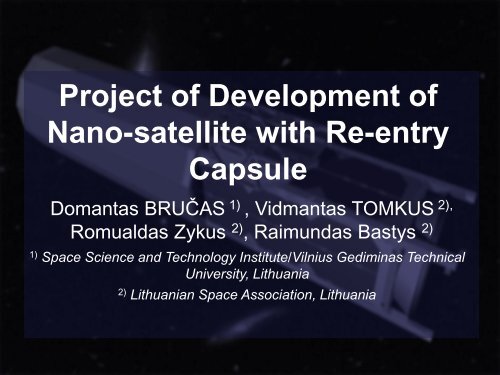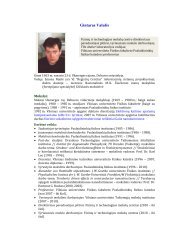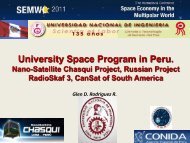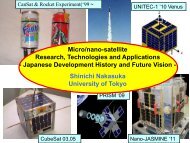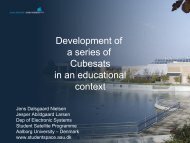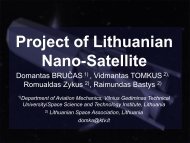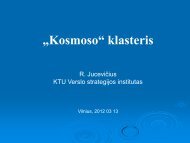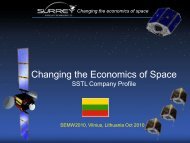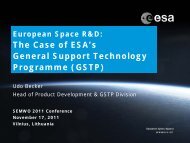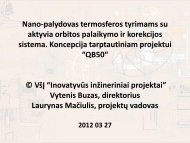Project of Development of Nano-satellite with Re-entry Capsule
Project of Development of Nano-satellite with Re-entry Capsule
Project of Development of Nano-satellite with Re-entry Capsule
You also want an ePaper? Increase the reach of your titles
YUMPU automatically turns print PDFs into web optimized ePapers that Google loves.
<strong>Project</strong> <strong>of</strong> <strong>Development</strong> <strong>of</strong><br />
<strong>Nano</strong>-<strong>satellite</strong> <strong>with</strong> <strong>Re</strong>-<strong>entry</strong><br />
<strong>Capsule</strong><br />
Domantas BRUČAS 1) , Vidmantas TOMKUS 2),<br />
Romualdas Zykus 2) , Raimundas Bastys 2)<br />
1)<br />
Space Science and Technology Institute/Vilnius Gediminas Technical<br />
University, Lithuania<br />
2)<br />
Lithuanian Space Association, Lithuania
INTRODUCTION<br />
The Lithuanian Energy Institute and the Institute <strong>of</strong> Biochemistry participated in<br />
the soviet space program "Mars“;<br />
The Institute <strong>of</strong> Botany researched plant-physiology at zero gravity conditions at<br />
Salyut and Mir orbital stations;<br />
Faculty <strong>of</strong> Semiconductor Physics <strong>of</strong> Vilnius University developed photodetector<br />
arrays <strong>of</strong> robotic vision systems for the Lunar rover “Lunokhod”;<br />
Lithuanian Textile Institute developed technology <strong>of</strong> heat insulation<br />
panels for the shuttle “Buran”;<br />
Kaunas University <strong>of</strong> Technology researched a piezoelectric<br />
control and vibrotechnics systems <strong>of</strong> liquid-fuel rocket engines;<br />
Direct access to the<br />
space has been lost for<br />
the last 20 years;<br />
2011.07.12 <strong>Project</strong> <strong>of</strong> <strong>Development</strong> <strong>of</strong> <strong>Nano</strong><strong>satellite</strong><br />
2<br />
<strong>with</strong> <strong>Re</strong>-<strong>entry</strong><br />
<strong>Capsule</strong>
MAIN AREAS OF ACTIVITIES<br />
• Microsensors &<br />
microactuators - MEMS, MEOMS<br />
• Thermoaerodinamics<br />
• ICT<br />
• Space science – microgravity and astrophysics<br />
2011.07.12 <strong>Project</strong> <strong>of</strong> <strong>Development</strong> <strong>of</strong> <strong>Nano</strong><strong>satellite</strong><br />
3<br />
<strong>with</strong> <strong>Re</strong>-<strong>entry</strong><br />
<strong>Capsule</strong>
GENERAL IDEA OF THE PROJECT<br />
Idea <strong>of</strong> the mission should be new,<br />
interesting from scientific point <strong>of</strong><br />
view and involve previous works;<br />
Idea – to construct nano-<strong>satellite</strong><br />
<strong>with</strong> a capsule capable <strong>of</strong> reentering<br />
Earth atmosphere;<br />
Satellite should consists <strong>of</strong>:<br />
1. Service module;<br />
2. <strong>Re</strong>search module – re-<strong>entry</strong><br />
capsule <strong>with</strong> 100 g <strong>of</strong> scientific<br />
payload;<br />
2011.07.12 <strong>Project</strong> <strong>of</strong> <strong>Development</strong> <strong>of</strong> <strong>Nano</strong><strong>satellite</strong><br />
4<br />
<strong>with</strong> <strong>Re</strong>-<strong>entry</strong><br />
<strong>Capsule</strong>
SERVICE MODULE<br />
2U – 3U type CUBESAT;<br />
Standard main processor <strong>with</strong> the<br />
possibility <strong>of</strong> devices control by means <strong>of</strong><br />
the analogue signals;<br />
Standard means <strong>of</strong> communication;<br />
Standard means <strong>of</strong> attitude<br />
determination;<br />
Means <strong>of</strong> active propulsion for controlled<br />
deceleration;<br />
Some special means <strong>of</strong> attitude control;<br />
Advanced launch container.<br />
2011.07.12 <strong>Project</strong> <strong>of</strong> <strong>Development</strong> <strong>of</strong> <strong>Nano</strong><strong>satellite</strong><br />
5<br />
<strong>with</strong> <strong>Re</strong>-<strong>entry</strong><br />
<strong>Capsule</strong>
SATELLITE DECELLERATION<br />
Initially an elliptical orbit <strong>of</strong><br />
200x800 km was considered;<br />
Gradual self deceleration could be<br />
implemented;<br />
For a final controlled deceleration<br />
special steam “canon” (based on<br />
the water resistor-jet principle) was<br />
developed;<br />
Large batteries and solar cells had<br />
to provide power for a final “shot”.<br />
2011.07.12 <strong>Project</strong> <strong>of</strong> <strong>Development</strong> <strong>of</strong> <strong>Nano</strong><strong>satellite</strong><br />
6<br />
<strong>with</strong> <strong>Re</strong>-<strong>entry</strong><br />
<strong>Capsule</strong>
SATELLITE DECELLERATION<br />
“Green” rocket fuel is planned to be implemented;<br />
Depending on the main payload carrier<br />
800 km circular orbit is probable;<br />
More reliable active propulsion must be<br />
implemented for ensuring low landing<br />
scattering;<br />
Mono-propellant 1 N rocket thruster is<br />
planned to be implemented;<br />
Negotiations considering certification <strong>of</strong> the thruster are held.<br />
2011.07.12 <strong>Project</strong> <strong>of</strong> <strong>Development</strong> <strong>of</strong> <strong>Nano</strong><strong>satellite</strong><br />
<strong>with</strong> <strong>Re</strong>-<strong>entry</strong> <strong>Capsule</strong><br />
7
SATELLITE DECELLERATION<br />
Initial calculations on<br />
constructing a low cost simple<br />
high power active thruster have<br />
been done.<br />
Initial testing model <strong>of</strong> the<br />
thruster is manufactured.<br />
Test facilities are being<br />
prepared.<br />
The thruster to be created (as a final product) should be capable <strong>of</strong><br />
performing during 15-20 min (for deceleration needed for deorbiting) ,<br />
therefore budget materials and technologies have to be implemented to<br />
decrease the cost <strong>of</strong> the thruster.<br />
2011.07.12 <strong>Project</strong> <strong>of</strong> <strong>Development</strong> <strong>of</strong> <strong>Nano</strong><strong>satellite</strong><br />
<strong>with</strong> <strong>Re</strong>-<strong>entry</strong> <strong>Capsule</strong><br />
8
ATTITUDE CONTROL<br />
For accurate landing in<br />
predefined area <strong>of</strong> the earth<br />
attitude <strong>of</strong> <strong>satellite</strong> must be<br />
precisely controlled;<br />
Attitude control is a serious<br />
problem during <strong>satellite</strong><br />
deceleration;<br />
No other mean but active<br />
thrusting could ensure reliable<br />
attitude control at low altitudes;<br />
Special thrust vector control system suitable for nano-sat is under<br />
development.<br />
Cold gas thruster system is also considered for the attitude control.<br />
2011.07.12 <strong>Project</strong> <strong>of</strong> <strong>Development</strong> <strong>of</strong> <strong>Nano</strong><strong>satellite</strong><br />
<strong>with</strong> <strong>Re</strong>-<strong>entry</strong> <strong>Capsule</strong><br />
9
THRUST VECTOR CONTROL<br />
SYSTEM<br />
Thrust vector changing system relying on<br />
the screw-nut gear <strong>with</strong> step motors is under<br />
construction.<br />
System ensures continuous smooth vector<br />
adjustment during the phase <strong>of</strong> deceleration.<br />
Step motors<br />
Thruster nozzle<br />
Screw-nut gears<br />
2011.07.12 <strong>Project</strong> <strong>of</strong> <strong>Development</strong> <strong>of</strong> <strong>Nano</strong><strong>satellite</strong><br />
<strong>with</strong> <strong>Re</strong>-<strong>entry</strong> <strong>Capsule</strong><br />
10
RE-ENTRY CAPSULE<br />
800 – 1000 g re-<strong>entry</strong> capsule has to be<br />
constructed;<br />
<strong>Capsule</strong> should be capable <strong>of</strong> carrying up<br />
to 100 g <strong>of</strong> scientific payload;<br />
<strong>Capsule</strong> should separate at low altitude<br />
(approx. 100 km) and re-enter the<br />
atmosphere <strong>with</strong> a ballistic trajectory;<br />
Heat shield must protect capsule and the payload during re-<strong>entry</strong>;<br />
Due to the low mass <strong>of</strong> capsule rapid deceleration will occur.<br />
2011.07.12 <strong>Project</strong> <strong>of</strong> <strong>Development</strong> <strong>of</strong> <strong>Nano</strong><strong>satellite</strong><br />
11<br />
<strong>with</strong> <strong>Re</strong>-<strong>entry</strong><br />
<strong>Capsule</strong>
RE-ENTRY<br />
Number <strong>of</strong> shapes <strong>of</strong> re-<strong>entry</strong><br />
capsule were considered;<br />
Blunt nose body shape<br />
capsule was chosen as most<br />
suitable one.<br />
2011.07.12 <strong>Project</strong> <strong>of</strong> <strong>Development</strong> <strong>of</strong> <strong>Nano</strong><strong>satellite</strong><br />
12<br />
<strong>with</strong> <strong>Re</strong>-<strong>entry</strong><br />
<strong>Capsule</strong>
LANDING OF RE-ENTRY CAPSULE<br />
S<strong>of</strong>t landing by means <strong>of</strong> special parachute is<br />
planned.<br />
Parachuting system should both provide s<strong>of</strong>t<br />
landing and floatation in case <strong>of</strong> water landing.<br />
Position determination <strong>of</strong> capsule should be done<br />
by GPS receiver and mobile <strong>satellite</strong> modem.<br />
2011.07.12 <strong>Project</strong> <strong>of</strong> <strong>Development</strong> <strong>of</strong> <strong>Nano</strong><strong>satellite</strong><br />
13<br />
<strong>with</strong> <strong>Re</strong>-<strong>entry</strong><br />
<strong>Capsule</strong>
CONCLUSIONS<br />
1. Satellite under construction should consist <strong>of</strong> two parts – service<br />
module constructed <strong>of</strong> reliable components and re<strong>entry</strong> capsule<br />
capable <strong>of</strong> safe bringing down <strong>of</strong> 100 g <strong>of</strong> payload;<br />
2. Special heat protection materials and shapes <strong>of</strong> capsule are<br />
investigated;<br />
3. Special high thrust active propulsion system suitable for<br />
implementation on nano-sats is being developed;<br />
4. S<strong>of</strong>t landing and on-Earth position determination instrumentation<br />
is being prepared;<br />
5. Approaches and technologies tested on the nano-sat under<br />
construction could later be implemented on other nano-<strong>satellite</strong>s.<br />
2011.07.12 <strong>Project</strong> <strong>of</strong> <strong>Development</strong> <strong>of</strong> <strong>Nano</strong><strong>satellite</strong><br />
<strong>with</strong> <strong>Re</strong>-<strong>entry</strong> <strong>Capsule</strong><br />
14
THANK YOU FOR YOUR<br />
ATTENTION<br />
2011.07.12 <strong>Project</strong> <strong>of</strong> <strong>Development</strong> <strong>of</strong> <strong>Nano</strong><strong>satellite</strong><br />
<strong>with</strong> <strong>Re</strong>-<strong>entry</strong> <strong>Capsule</strong><br />
15


